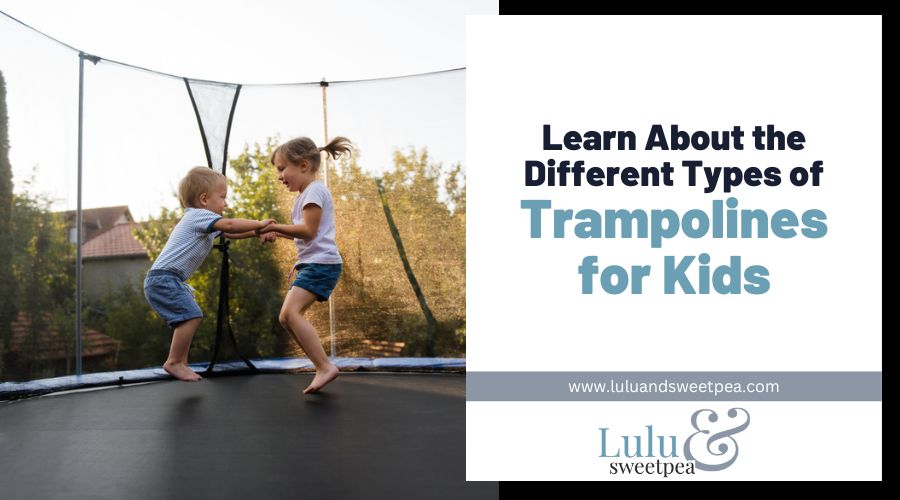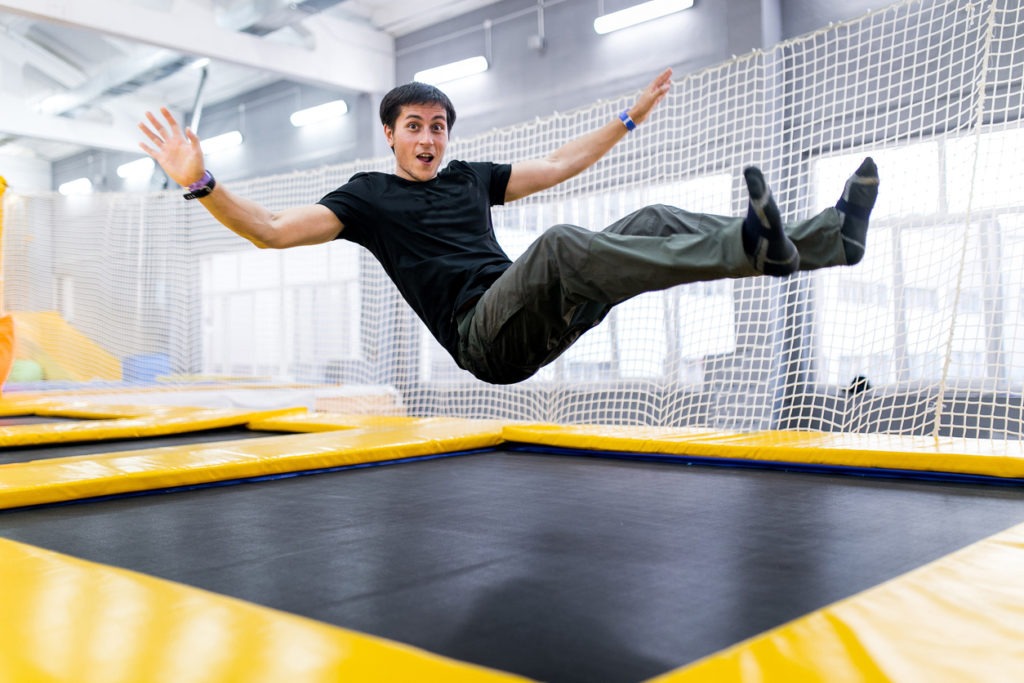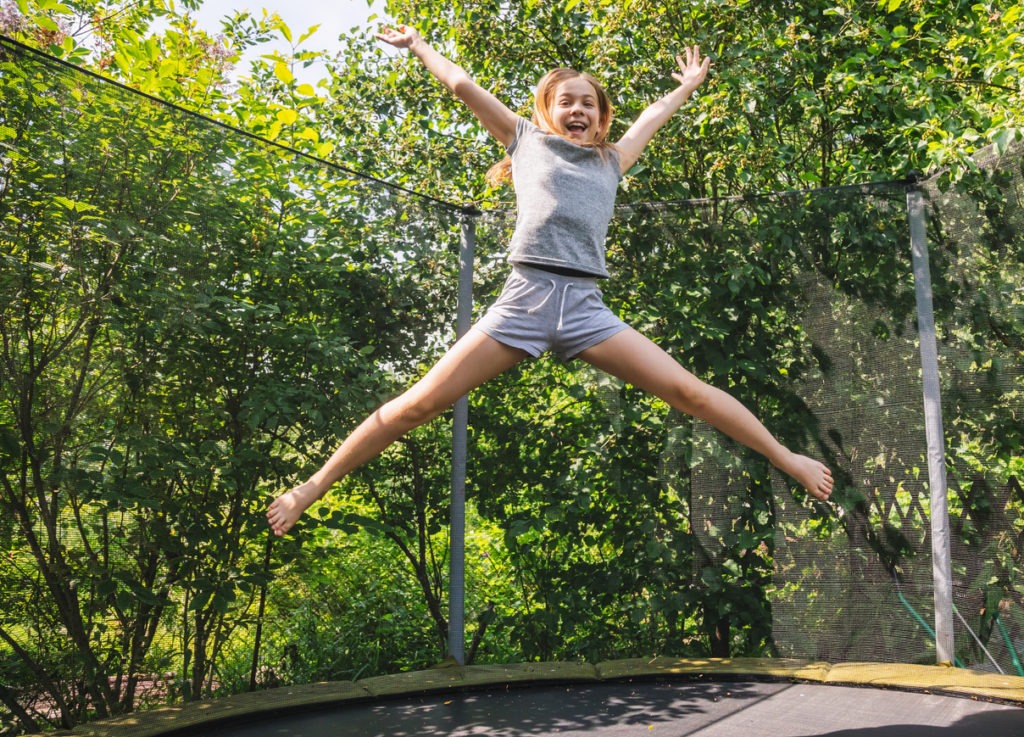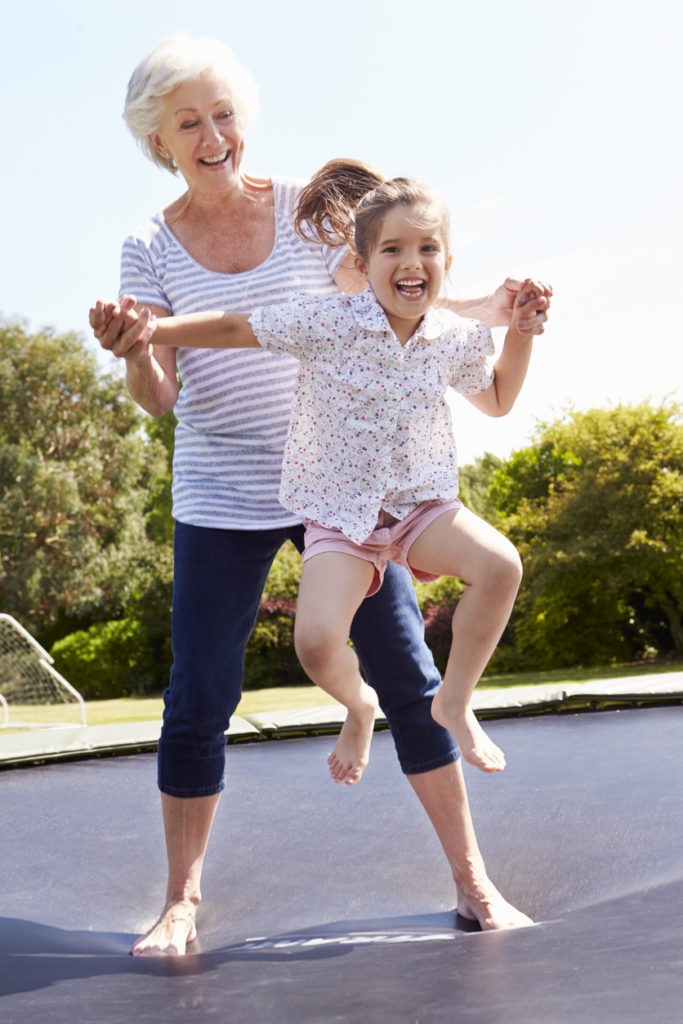A trampoline is a piece of strong, taut fabric that is stretched between a steel frame by many springs. The Springfree Trampoline doesn’t have springs; instead, it has glass-reinforced plastic rods. People jump on trampolines for fun and to win competitions.
The fabric that people bounce on, which is often called the “bounce mat” or “trampoline bed,” is not elastic. Instead, the springs that connect the fabric to the frame are elastic because they store potential energy.
Types of Trampolines
Trampolines can be used in many ways, both for work and for fun. Because of this, there are a lot of options to think about if you want to add one to your backyard. You should think about both the size and shape of the trampoline, especially if you want to put it in your backyard next to something like a wooden swing set.
Mini Bouncer Trampolines
The smallest size for people who are just starting out. These mini bouncer trampolines are small enough to fit inside the house and are great for toddlers or kids who need help getting active. With a metal frame and a stable handle, these trampolines can be used as a safe jumping mat to help kids learn balance and coordination.
Mini bouncers can hold up to about 25 kg of weight on average.
Junior Trampoline Sizes
The junior size trampoline is for kids between the ages of three and ten. These range in size from 4.5 feet to 7 feet around.
4.5-foot trampolines are for single jumpers and kids who aren’t very tall. They come in different colors, like pink, blue, and prints. With their padded nets, these first-time trampolines are great for getting young kids used to jumping and bouncing on outdoor equipment.
A 6-foot trampoline gives kids more room to jump. A 6-foot trampoline is made for kids ages 3 to 10, but adults can also use it. The netting around the Plum Magnitude trampoline is shaped like a curve to give you the most jumping space and safety.
Even though a 7-foot junior jumper is wider than other options, the frame is kept low so that smaller children can easily get in and out of it. The longer springs on the 7-foot trampolines make it possible to jump higher.
Oval Trampoline Shapes
Oval trampolines are one of the more recent shapes on the market. They work very well and are great for both kids and adults. A good oval trampoline has a high net enclosure that separates the jumping area from the springs.
The oval shape is a good choice for a home trampoline because it gives you more room to jump than a typical round shape. People who jump on oval trampolines don’t end up in the middle of the mat. Because it is longer, the mat has two places to bounce, one at each long end of the oval.
Oval trampolines also give you more room to jump. Because it is bigger, a jumper has to work a little harder to make big jumps. All ages can use this to work out their legs.
Circular Trampoline Shapes
The most common shape for a trampoline in a backyard is a circle. Because the springs are evenly spaced around the trampoline mat, the jump is always the same and leads people back to the middle. Because of this, single users should use round trampolines to avoid running into each other.
The frame of a round trampoline takes in the force of each jump, which makes it less likely to shake or get out of balance. The frame of a round trampoline is lighter than the frames of other types. This means that they can start with a lower price.
This also means that the frame doesn’t take up as much space as an oval or rectangular trampoline. Smaller frames are easier to move so that they can be moved around the yard.
Circular trampolines are the most common, so there are many different kinds to choose from. This shape has something for every size family, from the junior sizes to the 14th Space Zone II.
Square Trampoline Shapes
People like square trampolines because they are big from corner to corner but don’t take up as much room as rectangular ones. This means that they are the right size to fit in a typical yard with other play equipment like a swing and slide unit. A square trampoline has more play space than a round or oval trampoline because it has corners.
Because of how the springs are set up on a square trampoline, it doesn’t bounce as hard as one that is oval or rectangular. This makes square mats great for younger children or for use by more than one person.
Trampoline Bowl Shapes
Plum’s brand-new design is a bowl-shaped trampoline. These trampolines are called “free bound” trampolines, and they offer the most fun and safest way to bounce. Instead of a flat jumping mat, the trampoline has a curved and shaped floor that lets you move around and land on the walls that bounce back up.
By replacing the metal springs with bungee cords, the trampoline can be used without making noise. Kids who want to literally jump off the walls will love this trampoline shape. This trampoline can hold more weight than other traditional models, so it can grow with your kids as they do.
It can also be used for a wide range of other sports. Gymnasts and acrobats who are good at what they do love that they can move safely around the bowl. And skateboarders, skiers, figure skaters, and other athletes who like to try new things can practice flips and turns.
Rectangular Trampoline Shapes
The rectangular bouncer is the most common shape for a gymnastics trampoline, and it gives the highest jumps. The most surface area is also found on rectangular trampolines. This is the right shape of trampoline if you have teenagers, acrobats, or gymnasts in your family.
The springs on a rectangular trampoline move in their own ways because of the shape of the trampoline. This helps you control how high you jump and how you land. You don’t end up in the middle of the mat, which is the best place to practice aerial moves.
For adults and older kids, it’s best to get a rectangular trampoline. Younger children need to be watched because they can bounce extra high.
The most weight can be put on trampolines that are shaped like this. Because the frame and mat of these trampolines are bigger than those of other types, they usually cost more.
Trampoline Benefits for Kids
Trampolines are fun. When you’re having childlike fun, it’s hard not to smile. Regular trampoline use has health benefits. And there are mental benefits too. Trampoline benefits for kids include:
1. Heart Health.
Bouncing for 10 minutes a day increases heart rate and strengthens heart muscles. Your youngsters have so much fun playing and bouncing that they don’t realize the cardiac benefits.
2. Strong immunity.
Trampoline jumping stimulates internal organs and increases lymphatic circulation, which detoxifies and strengthens the body. It removes contaminants and lets nutrients in.
3. Energized.
As kids bounce, their blood carries more oxygen. This boosts their vitality and alertness. Start the day by getting your kids active.
4. Refreshing!
A trampoline keeps kids healthy by getting them active and outside for fresh air. Instead of indoor, inactive play, they’ll get vitamin D in the sun while playing.
5. Motor coordination.
Many of us don’t realize it, but trampoline jumping requires coordination [cue pride for those of us who have been dubbed ‘uncoordinated’]. This is especially true as kids gain balance. Bouncing on a trampoline shifts kids’ center of gravity, requiring them to alter their stances and bilateral motions. Combining jumping, balance, and concentration helps kids enhance their motor skills, balance, and co-ordination.
6. Mindful.
Jumping makes people joyful. Increased oxygen circulation releases mood-boosting endorphins. Trampoline jumping is entertaining and helps our kids unwind after a long day. Rebounding on a trampoline develops concentration, fun, and repetition.
7. Boosting confidence.
Trampolines are wonderful for kids who are nervous about new things and physical activity. There’s no wrong way to move on a trampoline (given you jump safely), so they feel rapid achievement, which boosts their daring and self-confidence.
8. Easy Learning!
It helps kids learn. Trampolining can increase learning by calming and focusing kids. Trampolines can be a useful learning aid. Kids can learn through play by counting, jumping on colored shapes, and following directions.
Physical activity promotes cognitive function; thus, it can also assist kids learn. Exer-learning combines exercise and learning.
Criteria Trampoline Selection
Think about the following things when choosing the best trampolines for kids:
Size: Whether you want a trampoline for indoors or outdoors, you probably have limited space.
Appropriateness for Age: You might be looking for a trampoline for your 3-year-old child right now, but you also want it to work for your family as that child gets older.
How easy it is to put together: This is important for people who don’t want to deal with long or complicated set-ups.
Safety Features: When kids jump, they need an adult to watch them and make sure they follow strict safety rules. But some parts of a trampoline might help keep your kids safe.
Durability: You want to know that your trampoline will hold up to active, enthusiastic kids jumping on it often and regularly.
Price: Who doesn’t want more for less money? P I know that price can be a big factor when deciding which trampoline is “best” for your family.
Warranty: What happens if something doesn’t work out as planned? Make sure to know the information about warranties.
Trampoline Safety Instructions
Please consider the following recommendations if you have a trampoline at home or your children have access to one and you continue to allow them to use it. Even if your kids complain about them, remember that they may be keeping them out of the ER.
- Only admit one individual at a time.
- Having an adult present is a must at all times.
- Don’t do summersaults or flips (so you don’t hurt your head or neck).
- Do not perform any backflips or summersaults (this will help prevent injuries to the head and neck)
- If you want to prevent head and neck injuries, don’t do any summersaults or flips, and have the equipment checked regularly. Also, make sure there’s enough padding.
- Homeowners should check their homeowner’s insurance for coverage connected to accidents incurred on their trampoline and should not maintain a ladder at or near the base of the trampoline to avoid enabling children access without supervision.
Conclusion
Always, we encourage all children to get outside and be active; however, it is important to keep in mind that there are numerous activities that children can take part in that are considerably less likely to result in harm. The trampoline with a protective enclosure is the most secure option.




